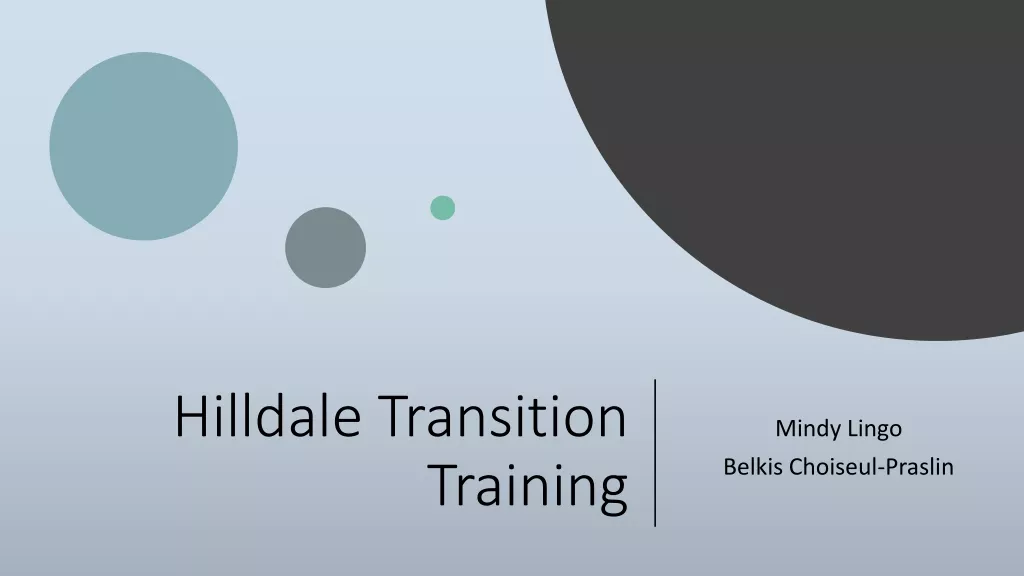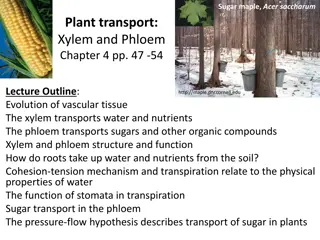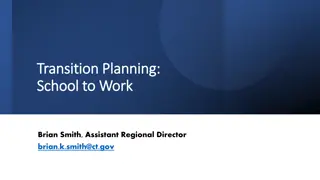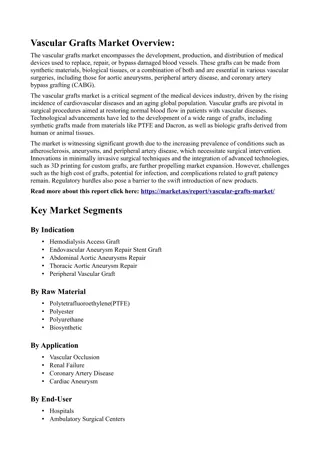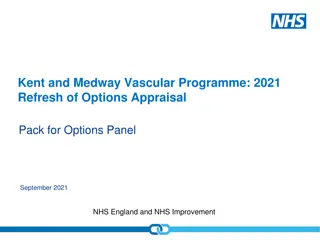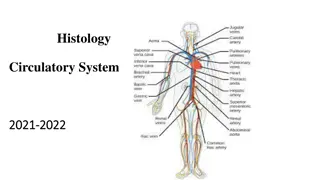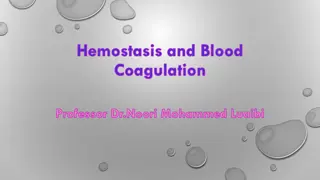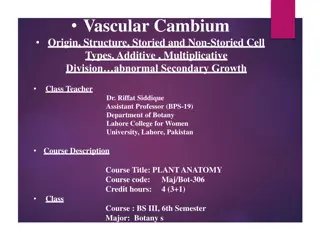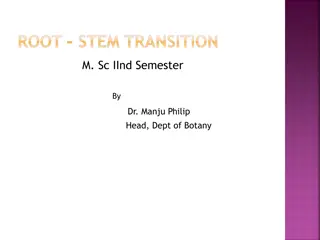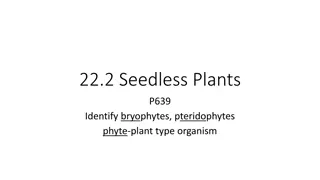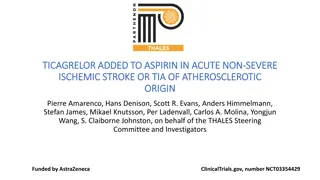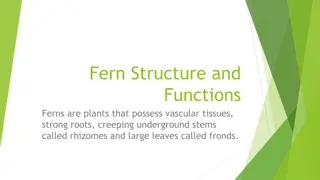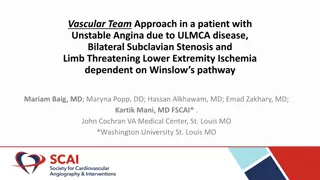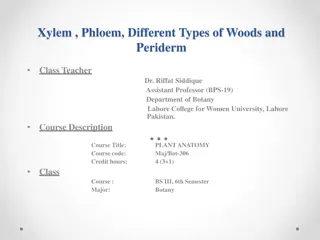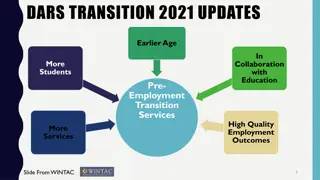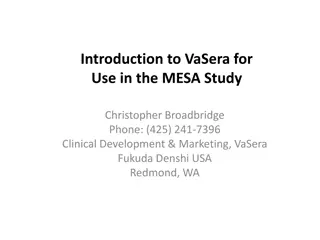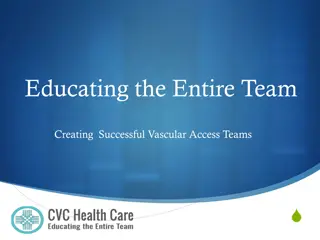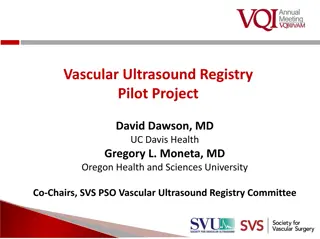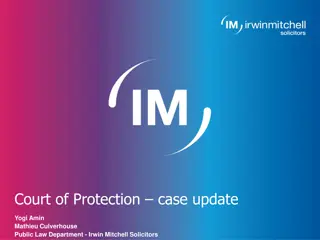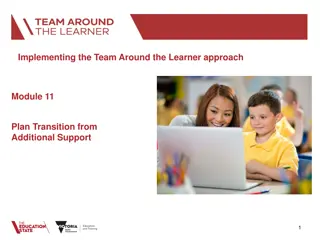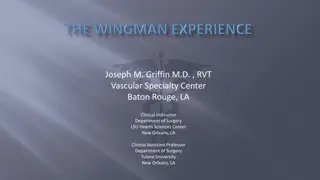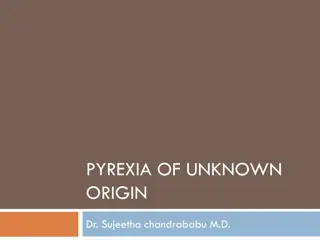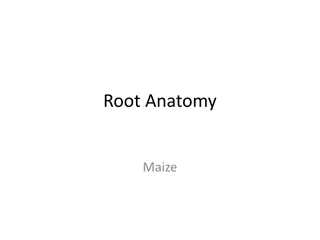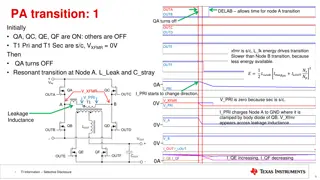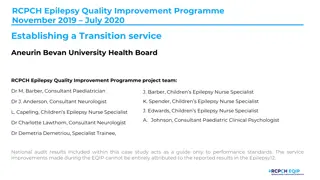Non Coronary Vascular Stents
Safe scanning of patients with non-coronary vascular stents (NCVS) in MRI settings in NHS Scotland. It covers key questions regarding the safety of patients with NCVS, including risks associated with MRI at different strengths, timing of MRI post-stent implantation, and the safety of various stent m
1 views • 9 slides
Green Transition Pillar: Shaping the Green Transition Actions
The Green Transition Pillar outlines actions to support Member States in updating national climate adaptation strategies, uptake of climate-proofing guidance, and promoting tools for climate risk assessments. It encourages the use of green budgeting, green public procurement, and disaster resilience
4 views • 9 slides
Understanding Special Education Transition: Goals, Assessments, and Legal Considerations
Exploring the purpose of special education under IDEA 2004, the importance of individualized transition plans, post-secondary goals, the role of transition assessments, and legal implications from case law decisions relating to inadequate transition planning. Key topics include Transition 101, IEP g
8 views • 151 slides
Understanding Plant Transport Systems: Xylem and Phloem
Explore the intricate system of plant transport through xylem and phloem, from how roots absorb water to the pressure-flow hypothesis in sugar transport. Learn about the evolution, structure, and function of vascular tissues and the critical role of transpiration. Dive into the classification of pla
3 views • 27 slides
Empowering People Through STEP Provider Training
STEP (Supporting Transformation to Empower People) Provider Training Session aims to equip residential service providers with the knowledge and tools to support individuals in their transition towards independence. The training covers topics such as financial incentives, transition planning, and bui
0 views • 20 slides
Transition Planning for School to Work: A Comprehensive Guide
Transition planning is crucial for students moving from school to work life, involving tasks such as connecting with advisors, exploring decision-making options, obtaining necessary identification, and more. The role of the DDS Transition Advisor is pivotal in assisting students, families, and agenc
0 views • 7 slides
Vascular Grafts Market
The Global Vascular Grafts Market size is expected to be worth around USD 5.7 Billion by 2032 from USD 3.1 Billion in 2022, growing at a CAGR of 6.40% during the forecast period from 2023 to 2032.\n\n
0 views • 3 slides
Kent and Medway Vascular Programme: 2021 Refresh of Options Appraisal
The Kent and Medway Vascular Programme underwent a review in 2014 that identified the need for a different setup of vascular services due to existing providers not meeting national standards. Subsequent options appraisals in 2016 and beyond led to the recommendation of a single dedicated specialist
0 views • 21 slides
Understanding the Circulatory System: A Detailed Overview
The circulatory system plays a vital role in transporting nutrients, oxygen, and other essential substances throughout the body. It consists of the blood vascular system (arteries, arterioles, veins, capillaries, and the heart) and the lymphatic vascular system. Understanding the general structure o
0 views • 31 slides
Hemostasis and Blood Coagulation Mechanisms Explained
Hemostasis refers to the prevention of blood loss through vascular constriction, platelet plug formation, blood clotting, and fibrous tissue growth. Vascular constriction occurs immediately after vessel damage, initiated by myogenic spasm, autacoid factors, and nervous reflexes. Platelet plug format
0 views • 25 slides
Understanding Vascular Cambium in Plant Anatomy
Vascular cambium is a crucial growth layer in stems and roots, responsible for producing xylem and phloem in plants. It originates from the maturation of procambium cells, differentiating into storied and non-storied cell types. It plays a vital role in secondary growth by generating new wood in woo
0 views • 26 slides
Understanding Vascular Transition in Root-Stem Structure
Root and stem in plants form a continuous structure with a transition region between them. The transition involves twisting and inversion of xylem strands, leading to variations in vascular bundles. Eames and Mac Daniels identified different types of vascular transitions in dicots and monocots, each
1 views • 13 slides
Understanding Cellular Events in Inflammation and Repair
Explore the lecture on Cellular Events in Inflammation by Dr. Maha Arafah, focusing on the sequence of vascular changes in acute inflammation, phases of changes in vascular caliber and flow, and objectives covering leukocyte extravasation, chemotaxis, phagocytosis, and microbial killing. Reference m
0 views • 47 slides
Understanding Seedless Plants: Bryophytes and Pteridophytes
Explore the world of seedless plants through bryophytes and pteridophytes. Learn about the characteristics of green algae, the life cycles of these plants, and how vascular tissue impacts their growth. Discover the limitations and importance of vascular tissue in plants, from the small yet significa
0 views • 8 slides
Pharmacological Management of Alzheimer's Disease and Cognitive Enhancers
Cognitive enhancers play a crucial role in managing Alzheimer's Disease, with Cholinesterase inhibitors (AChEI) like Donepezil, Galantamine, and Rivastigmine recommended for mild to moderate AD, and Memantine for moderate to severe cases. These medications act through different mechanisms, with AChE
0 views • 46 slides
EU Just Transition Fund: Supporting Sustainable Growth and Climate Action
The European Commission's Just Transition Fund aims to support regions facing transition challenges by promoting clean energy, sustainable transport, greener industry, nature protection, and a just transition for all. The fund leverages public financing, provides grants, and crowds in private invest
4 views • 16 slides
Clinical Notes on Vascular Line & Fluid Therapy by Dr. Ali Egab
This collection of clinical notes by Dr. Ali Egab covers various aspects of vascular access, types of veins used for IV therapy, considerations in vein selection, equipment for IV therapy, cannula gauge, rate of infusion, and local complications of vascular lines. The notes provide valuable insights
0 views • 22 slides
Pediatric Vascular Access Techniques and Considerations
This article discusses various vascular access methods in infants and children, including peripheral IV access, central venous access, arterial lines, and ultrasound-guided techniques. It covers indications, sites, complications, and techniques for each method, emphasizing the importance of proper a
1 views • 56 slides
Ticagrelor Added to Aspirin in Acute Non-Severe Ischemic Stroke or TIA of Atherosclerotic Origin
Among patients with transient ischemic attack (TIA) or minor ischemic strokes, adding ticagrelor to aspirin has shown superior efficacy in preventing stroke or death, particularly in those with ipsilateral atherosclerotic stenosis. The THALES trial demonstrated that ticagrelor added to aspirin was m
0 views • 14 slides
Screening for Peripheral Vascular Disease in Patients with Coronary Artery Disease
Patients with coronary artery disease should be screened for peripheral vascular disease as it is a frequent integrator of global cardiovascular risk. The association of atherosclerosis in various arterial diseases highlights the importance of identifying multisite artery disease. The prevalence and
0 views • 23 slides
Complications of Fractures: Types and Risks
Complications of fractures can be classified as general, local early, and late complications. General complications include shock, embolisms, and fever while local complications involve injuries to nearby tissues and infections. Early local complications can lead to visceral, vascular, nerve injurie
0 views • 29 slides
Understanding the Structural Adaptations of Ferns and Tracheophytes
Ferns, as vascular plants, possess unique structural adaptations such as vascular tissues, tracheid cells, true roots, and leaves that enable them to thrive on land without depending on extremely wet environments. The intricate development of tracheophytes has shaped ferns' ability to transport wate
0 views • 8 slides
Vascular Team Approach in Unstable Angina with Complex Vascular Disease
A 73-year-old patient with COPD, hypertension, and hyperlipidemia presents with severe lower extremity ischemia, leading to a plan for urgent aorto-bifemoral bypass. The clinical examination and test results revealed critical limb ischemia and extensive vascular disease requiring intervention from c
0 views • 19 slides
Understanding Xylem, Phloem, and Vascular Bundles in Plant Anatomy
Exploring the intricate structures of xylem and phloem, essential components of plant vascular bundles. Discover the functions and components of xylem, including tracheides and vessels, as well as the patterns of secondary thickening. Learn about the roles of phloem in transporting nutrients through
0 views • 33 slides
Understanding Transition Bias and Substitution Models in Genetics
Transition bias and substitution models, explored by Xuhua Xia, delve into the concepts of transitions and transversions in genetic mutations, the causes of transition bias, the ubiquitous nature of transition bias in invertebrate and vertebrate genes, the mitochondrial genetic code, and RNA seconda
1 views • 25 slides
DARS Transition Updates 2021: Enhancing Education & Employment Transition Services
Updates from the Department for Aging and Rehabilitative Services (DARS) highlight improved collaboration with educational institutions, leading to better employment outcomes for youth with disabilities. The data reflects increased participation and services provided across different districts, focu
0 views • 11 slides
Introduction to VaSera for Vascular Function Measurement in MESA Study
Christopher Broadbridge introduces VaSera for vascular function measurement in the MESA study. VaSera, developed by Fukuda Denshi, offers non-invasive diagnostic tests sensitive to cardiovascular risk. The device, equipped with advanced features like CAVI and ABI tests, provides reliable measurement
0 views • 33 slides
Understanding Plant Classification and Characteristics
Discover the classification of plants based on their structures and characteristics, including vascular vs. nonvascular plants, seed plants vs. seedless plants, and the definitions of angiosperms, gymnosperms, dicots, and monocots. Learn about the history of plant classification and how plants are g
0 views • 27 slides
Building Successful Vascular Access Teams
Educate and empower your entire healthcare team on creating successful vascular access teams led by dedicated professionals. Learn the importance of team collaboration, choosing effective leaders, and enhancing the patient experience to achieve improved outcomes in vascular access care.
0 views • 14 slides
Advancing Vascular Ultrasound Through Registry Collaboration
The Vascular Ultrasound Registry Pilot Project, led by Dr. David Dawson and Dr. Gregory L. Moneta, aims to enhance research, education, and quality in vascular ultrasound. This initiative involves a formal collaboration between SVS PSO, SVU, and M2S/Medstreaming to integrate images and data into cli
0 views • 19 slides
Case Update: Court of Protection - AJ's Journey with Vascular Dementia
AJ, an 88-year-old with vascular dementia, faced challenges with care arrangements leading to her stay in a care home. Issues arose due to lack of effective communication between family members and authorities. Legal appointments, including IMCA and RPR, were made to support AJ. The case highlights
0 views • 23 slides
Transition Planning for Community Treatment Programs
Oregon Center of Excellence for Assertive Community Treatment focuses on transition planning to help individuals move from intensive services to less intensive ones. Research shows that only a small percentage of individuals are ready to transition after being served by ACT for years. Topics covered
0 views • 23 slides
Transition from Additional Support: Module 11 Overview & Plan
Module 11 focuses on planning the transition from additional support for learners and families. It covers recognizing when to plan the transition, developing transition plans, celebrating successes, and following up with the learner and family to ensure continued success. The process involves initia
0 views • 8 slides
Enhancing Secondary Transition Services: Key Strategies for Indicator 13 Implementation
Learn about the essential components of Indicator 13 in secondary transition services, including transition assessment, goal-setting, alignment of IEP goals, and coordination for successful student outcomes. Discover why transition assessment is crucial, how it informs the planning process, and the
0 views • 51 slides
Vascular Cases and Interventions Overview
Joseph M. Griffin, MD, RVT, a clinical instructor and assistant professor in surgery, presents cases involving vascular lesions, patient characteristics, and treatment approaches. Cases include individuals with peripheral artery occlusions, comorbidities such as hypertension and diabetes, and unsucc
0 views • 23 slides
Understanding Pyrexia of Unknown Origin: Causes and Classification
Pyrexia of unknown origin (PUO) is a challenging diagnostic scenario characterized by persistent fever without an identified cause. Dr. Sujeetha Chandrababu M.D. defined PUO as temperatures exceeding 38.3°C for several weeks with no definitive diagnosis. Classification of PUO includes various categ
0 views • 43 slides
Maize Root Anatomy: An In-depth Examination
Maize root anatomy involves various specialized structures such as the epidermis, cortex, endodermis, pericycle, and vascular tissue. The epidermis is crucial for absorption and protection, while the cortex plays a role in providing support and storage. The endodermis acts as a barrier and regulates
0 views • 9 slides
Understanding Passive/Active Resonant Transition in Power Amplifier
DELAB allows time for node A transition in PA with OUTA and OUTB. The transition is slower than AP transition, making ZVS harder to achieve across load range due to less energy. Transition time is shorter at higher currents, and the controller can adjust delays adaptively. Remember, the conditions f
0 views • 12 slides
Establishing Transition Service for Young Epilepsy Patients at Aneurin Bevan University Health Board
The RCPCH Epilepsy Quality Improvement Programme at Aneurin Bevan University Health Board aimed to improve the transition process for young epilepsy patients. The project team implemented the Ready, Steady, Go model to educate teenagers about managing their condition independently. Changes included
0 views • 15 slides
Managing Catheter-Related Bloodstream Infections in Vascular Access
Reduce and prevent catheter-related bloodstream infections in vascular access by addressing extraluminal infection sources and implementing strategies outlined in national drivers such as the NHS Long Term Plan and the Antimicrobial Resistance Action Plan. Recognize the importance of tackling antimi
0 views • 25 slides


